Elusions: Final Fantasy 64
 In the world of unreleased video games, there is often an abundance of conjecture sprinkled with
a smattering of fact. Over time, the facts become confused with the rumors, and the truth
becomes obscured. Technical demos become completed games, and concept art becomes canon.
In the world of unreleased video games, there is often an abundance of conjecture sprinkled with
a smattering of fact. Over time, the facts become confused with the rumors, and the truth
becomes obscured. Technical demos become completed games, and concept art becomes canon.
We here at Lost Levels strive to uncover the facts concerning games that, for whatever reason, never made it to release. Elusions focuses on unpublished games that have not yet been tracked down, either by outside hobbyists or by ourselves. This month, we seek to remove the rumors and lay bare the facts about one such game, Final Fantasy 64.
Well, that is to say, Final Fantasy VII. Or, if you prefer, Final Fantasy x, which is completely different from Final Fantasy X. Wait, no, it's really called the Final Fantasy SGI Demo.
Of course.
- By Kenny Sutherland
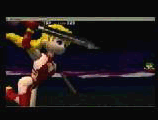 The Final Fantasy series of role-playing games (RPGs) created by Square Co., Ltd. and
currently owned by Square-Enix, Inc. is one of the most well known video game series in history.
Featuring over a dozen titles on more than half a dozen console and handheld gaming systems,
the series has reached a large and diverse audience.
The Final Fantasy series of role-playing games (RPGs) created by Square Co., Ltd. and
currently owned by Square-Enix, Inc. is one of the most well known video game series in history.
Featuring over a dozen titles on more than half a dozen console and handheld gaming systems,
the series has reached a large and diverse audience.
Fans of the games are numerous, and sales are usually high, with more than ten million copies of the first six titles being sold in Japan alone. Information about the Final Fantasy games, from verified facts to unsubstantiated rumors, is spread through video game magazines and on the internet via websites, message forums, newsgroups, and other such media. Some people have even based their choice of console system upon the absence or presence of Final Fantasy titles. Such was the case in the mid 1990s, when the Sony PlayStation and the upcoming Nintendo Ultra 64 were positioning themselves for dominance of the console market.
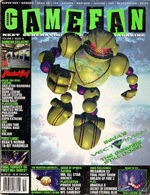 Ten years ago, in October of 1995, an article by Nick Rox run in Volume 3, Issue 10 of Diehard
GameFan Magazine showed images of what were believed to be "actual screen shots of a game
currently in development for Nintendo's Ultra 64." The images were from a demo of a technical
demonstration that "in many a gamer's opinion, is THE U64 game: Final Fantasy VII."
Ten years ago, in October of 1995, an article by Nick Rox run in Volume 3, Issue 10 of Diehard
GameFan Magazine showed images of what were believed to be "actual screen shots of a game
currently in development for Nintendo's Ultra 64." The images were from a demo of a technical
demonstration that "in many a gamer's opinion, is THE U64 game: Final Fantasy VII."
Not only did the GameFan article name the game as Final Fantasy VII and claim that it was to be released on the Ultra 64, but it also proclaimed a release date of December 1996 and that the details about the game came from "a member of the cart's staff," which would imply that the game was to be released in a cartridge format. These solid proclamations about the demo led many fans to believe that a new Final Fantasy title was already in the works for the Nintendo 64.
Other gaming magazines, including Nintendo Power, also ran articles on the demo with different information, helping to fuel the rumors of an upcoming Nintendo 64 Final Fantasy title. When no further information about the game appeared and Square subsequently announced that a game titled Final Fantasy VII would be released on the Sony PlayStation, fans cried foul and accused Square of betraying Nintendo. Sony was accused of stealing developers from Nintendo systems. Square was also accused of signing a deal with Sony to produce games exclusively for Sony consoles.
Most of these claims were nothing more than rumors that were spawned as the result of some shoddy journalism; however, many people accepted these rumors as fact, and these faux facts were perpetuated as being truths.
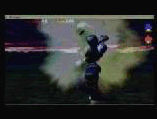 But many rumors are based in fact, and the rumors surrounding Final Fantasy 64 are no
exception. The images of the demo that were shown in GameFan, Nintendo Power, and
other magazines were real, which meant that the demo itself was real. So what exactly was the
demo, and where had the information in the magazines come from?
But many rumors are based in fact, and the rumors surrounding Final Fantasy 64 are no
exception. The images of the demo that were shown in GameFan, Nintendo Power, and
other magazines were real, which meant that the demo itself was real. So what exactly was the
demo, and where had the information in the magazines come from?
At the ACM SIGGRAPH 95 convention, held from August 6 to August 11, 1995 in Los Angeles, California, Square unveiled an interactive technical demo displaying a 3D battle scene between characters and enemies from Final Fantasy VI, which had been released as Final Fantasy III on the Super Nintendo Entertainment System in North America.
The demo ran on Silicon Graphics, Inc. (SGI) ONYX workstations, which are primarily used for graphics-intensive 3D modeling. This was how the demo came to be known as the Final Fantasy SGI Demo. The fact that Nintendo had teamed with SGI to develop the graphics engine for the Ultra 64 was seen as further proof that Square was developing a Final Fantasy title for the upcoming Nintendo system.
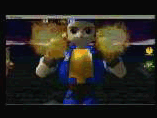 During the demo, the camera angles constantly shift to show the action from multiple angles.
While this technique is fairly common in modern Final Fantasy games, it was new territory
at the time the demo was displayed. The 3D modeled characters that appear in the demo are Locke,
Shadow, and Terra. The three characters are shown battling a rock golem, and a variety of
physical attacks and magic spells are used to defeat the enemy. Locke casts some variety of Fire
magic, and Terra summons a monster that appears to be Bahamut to destroy the golem.
During the demo, the camera angles constantly shift to show the action from multiple angles.
While this technique is fairly common in modern Final Fantasy games, it was new territory
at the time the demo was displayed. The 3D modeled characters that appear in the demo are Locke,
Shadow, and Terra. The three characters are shown battling a rock golem, and a variety of
physical attacks and magic spells are used to defeat the enemy. Locke casts some variety of Fire
magic, and Terra summons a monster that appears to be Bahamut to destroy the golem.
Players control the characters in the demo by using mouse movements to issue commands. Drawing a specific shape with the mouse would cause the character to take a specific action. In this way, the technical demo shown at ACM SIGGRAPH 95 was different than the Final Fantasy VII demo for PlayStation 3 shown at the 2005 Electronic Entertainment Expo (E3) that displayed the opening from the PlayStation version of Final Fantasy VII: the Final Fantasy VII PlayStation 3 demo is just a PS3 rendered version of the intro from the original PlayStation game, but the Final Fantasy 64 SGI Demo is an interactive game in and of itself.
On January 12, 1996, Square announced the intention to release a title known as Final Fantasy VII on the Sony PlayStation. It was later announced that there were no plans to release the title on the Nintendo 64, which still had not been released at that time. This led many fans of the series who had believed that Square was going to release a Final Fantasy title on the upcoming Nintendo system to assume that Square had abandoned Nintendo, and that Sony had perpetrated a virtual coup in the video game industry and signed a contract with Square to release games exclusively on Sony platforms.
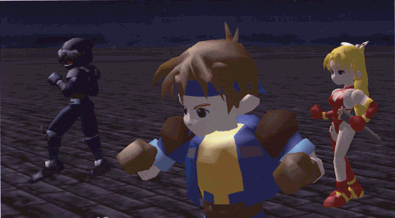
|
The reality of the situation was that the technical demo was nothing more than an experiment by Square. An interview with Hironobu Sakaguchi, the creator of the Final Fantasy series, from the PlayStation Underground #2 demo CD, elaborates on this:
"In August of 95, one of the US's largest CG conventions, SIGGRAPH, was held in Los Angeles. At that time we were not sure what the next generation RPG game should look like, so as an experiment we created a CG based, game like, interactive demo to be presented at the show. It focused on battle scenes that were 100% real time and polygon based. This became the seed of Final Fantasy VII and it was then that we decided to make this a CG based game."
Sakaguchi goes on to describe why the game had to be released on CD-ROM media, leading to the reason that the game was released for the PlayStation and could not be released for the Nintendo 64.
"When we discussed designing the field scenes as illustrations or CG based, we came up with the idea to eliminate the connection between movies and the fields. Without using blackout at all, and maintaining quality at the same time, we would make the movie stop at one cut and make the characters move around on it. We tried to make it controllable even during the movies. As a result of using a lot of motion data + CG effects and in still images, it turned out to be a mega capacity game, and therefore we had to choose CD-ROM as our media. It other words, we became too aggressive, and got ourselves into trouble."
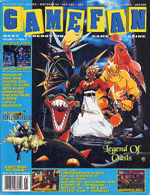 Although many fans continued to perpetuate the myth of a lost Final Fantasy 64 game, some
of the same magazines that had led to the creation of the rumors sought to clarify the situation.
In May of 1996, Volume 4, Issue 5 of Diehard GameFan Magazine contained one such follow-up:
Although many fans continued to perpetuate the myth of a lost Final Fantasy 64 game, some
of the same magazines that had led to the creation of the rumors sought to clarify the situation.
In May of 1996, Volume 4, Issue 5 of Diehard GameFan Magazine contained one such follow-up:
"Ah, remember SQUARE's beautiful SIGGRAPH demo (GF Vol. 3, Iss. 10)? Though it wasn't the Nintendo64 game everyone assumed it to be, it still holds a valuable spot in FF history as the most direct ancestor of FF VII's battle system. Believe it or not, it's actually a pretty cool (and totally playable) little game. Instead of the usual menu system, you control your characters by drawing shapes (a star for magic, for example) with the mouse."
The interactive Final Fantasy technical demo displayed at the ACM SIGGRAPH 95 conference was not a prototype of an upcoming game, nor was it a demo that was being developed specifically for the Nintendo 64 or for the Sony PlayStation. It was simply a technical demo that was designed to show what Square envisioned the next generation of RPGs to be, and to familiarize Square's software developers with the basics of 3D engines.
One question does remain unanswered: What exactly is the actual title of the interactive technical demo?
The demo was never intended to be developed into a game, so the work-in-progress title of "Final Fantasy x" is not plausible. Since it was not intended to be a game and was not intended to be released on any console, both Final Fantasy VII and Final Fantasy 64 can be ruled out as possible titles. And while the title "Final Fantasy SGI Demo" describes a technical aspect of the demo, it was not the actual title.
 The actual title of the interactive technical demo is Final Fantasy VI: The Interactive CG
Game. Scans from Issue 20 of the Japanese magazine Family Computer, dated October 6,
1995, clearly show an image of the title screen. The title can also be seen while viewing the
third of the three video files that can be found below, at about the one minute and eight second
mark, although the bottom half of the title is not legible in the video.
The actual title of the interactive technical demo is Final Fantasy VI: The Interactive CG
Game. Scans from Issue 20 of the Japanese magazine Family Computer, dated October 6,
1995, clearly show an image of the title screen. The title can also be seen while viewing the
third of the three video files that can be found below, at about the one minute and eight second
mark, although the bottom half of the title is not legible in the video.
Amongst all of the video game journalism and internet speculation about the origin of this demo, apparently no one got it right.
Even though Final Fantasy VI: The Interactive CG Game was not planned for release on any video game system, it is still a fully functional game. Perhaps some day it will be released to the public in some capacity, maybe even as a playable demo in a future Final Fantasy game, and fans of the series will truly get to appreciate it for themselves.
ACM SIGGRAPH is an organization that supports advances in computer graphics and interactive techniques. Special thanks to Viveka Weiley, Joe Flenser, and all the folks at ACM SIGGRAPH for their help in gathering decade-old information. Special thanks to Danny Cowan for providing the scans from Family Computer magazine. Also, thanks go out to all of the various sites that I ripped images and information from to use in this article.